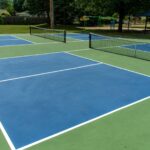Tennis courts have long been synonymous with athleticism, precision, and the joy of competition. However, there’s a new player on the court, and it’s bringing a wave of excitement and inclusivity – pickleball. Speak to any pickleball coach and they’ll tell you this fast-growing sport is quickly gaining popularity, and tennis court owners are taking notice, opting to convert their traditional courts into a haven for pickleball enthusiasts. In this blog post, we’ll explore the potential and process of transforming tennis courts into pickleball courts, highlighting the benefits, the conversion process, and the reasons behind this growing trend.
The Pickleball Explosion:
Pickleball, a sport that combines elements of tennis, badminton, and table tennis, has been steadily gaining momentum in recent years. Its popularity can be attributed to its accessibility for players of all ages and skill levels, making it an inclusive and fun alternative to traditional racquet sports. Pickle Court Construction, Australia’s leading specialist in pickleball court construction and conversions believes the driving factor behind the sport’s rise is its adaptability to existing tennis infrastructure, leading to a surge in the conversion of tennis courts into pickleball courts.
Benefits of Converting Tennis Courts to Pickleball Courts:
- Increased Utilisation: Pickleball courts are smaller than traditional tennis courts, allowing for the creation of multiple pickleball courts within the space of a single tennis court. This maximizes the use of existing facilities, catering to a broader range of players and enhancing the overall value of the space.
- Inclusivity: Pickleball’s smaller court size and slower pace make it accessible to players of all ages and fitness levels. The sport’s beginner-friendly nature encourages social interaction and fosters a sense of community, drawing in a diverse player base.
- Cost-Effective Conversion: Transforming a tennis court into a pickleball court is a cost-effective way to breathe new life into aging or underutilized facilities. The conversion process is relatively straightforward, allowing court owners to make the switch without a significant financial burden.
The Conversion Process:
Converting a tennis court into a pickleball paradise involves several key steps:
- Court Measurement and Marking: Pickleball courts are smaller than tennis courts, measuring approximately 6.1 meters by 13.4 meters for doubles and 6.1 meters by 6.7 meters for singles. The existing tennis court is measured and marked accordingly to accommodate the smaller dimensions of pickleball.
- Net Installation: Pickleball nets are set up at a height of approximately 86.4 centimeters at the center and 91.4 centimeters at the sidelines. Installing a net suitable for pickleball is a crucial step in the conversion process.
- Pickleball Court Surface: While many tennis courts already have suitable surfaces, some may require resurfacing to meet the specific requirements of pickleball. A smooth, non-slip surface is essential for optimal gameplay. The process of converting tennis courts into pickleball courts needs the right approach.
- Additional Court Markings: Pickleball courts have additional lines for serving, non-volley zones (the kitchen), and boundary lines. These markings are added to the existing tennis court surface to create a fully functional pickleball court.
Embracing the Trend:
As more tennis court owners recognise the potential and benefits of converting their facilities into pickleball courts, the trend is fast becoming a staple in recreational sports. The transition not only caters to the evolving preferences of players but also fosters a vibrant and welcoming atmosphere for all. So, whether you’re a tennis enthusiast looking for a new challenge or a facility owner seeking to revitalise your space, converting to pickleball might just be the ace up your sleeve!




